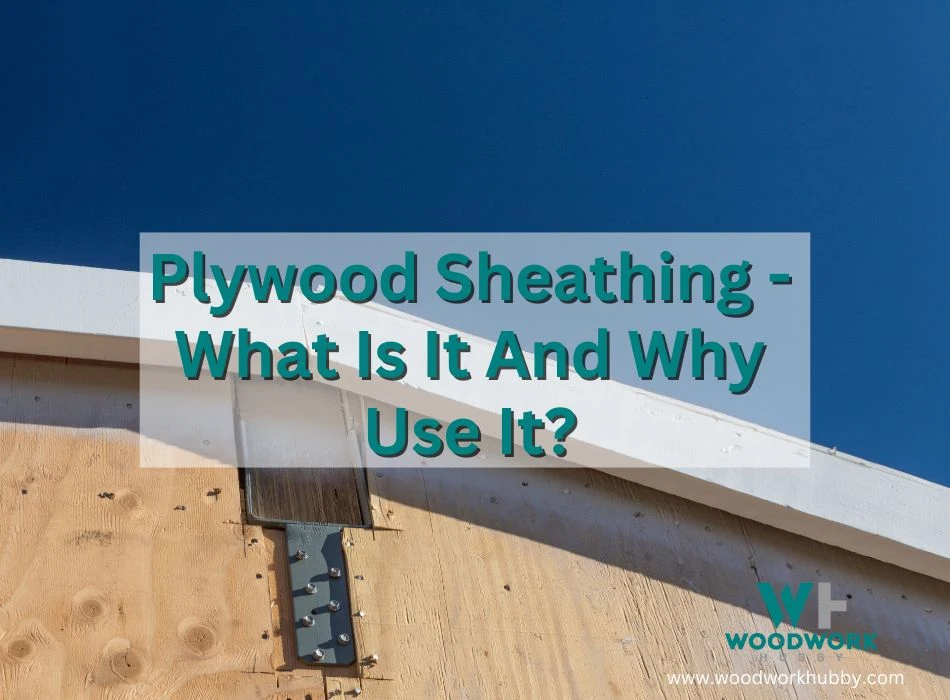From construction tasks to laying new flooring material, many aspects of construction work require making a choice regarding sheathing. When it comes to construction work, even with something as simple as a shed, plywood sheathing is often recommended. But before you can opt for it, you need to know what it is.
Plywood sheathing is a plywood board used to sheath a surface from heat transfer or internal impact. It is thin and sturdy when used for structural strength and thick and soft when used for temperature regulation. There is no universal standard for plywood sheathing.
In this article, you will learn more about plywood sheathing, its two types, and its weaknesses and strengths. By the end of the post, you’ll know whether you should get plywood for a specific sheathing job or not.
More importantly, you’ll know which type of plywood to get and which mistakes to avoid. But first, I’ll go over the two types of sheathing in construction.
What Is Sheathing Plywood?
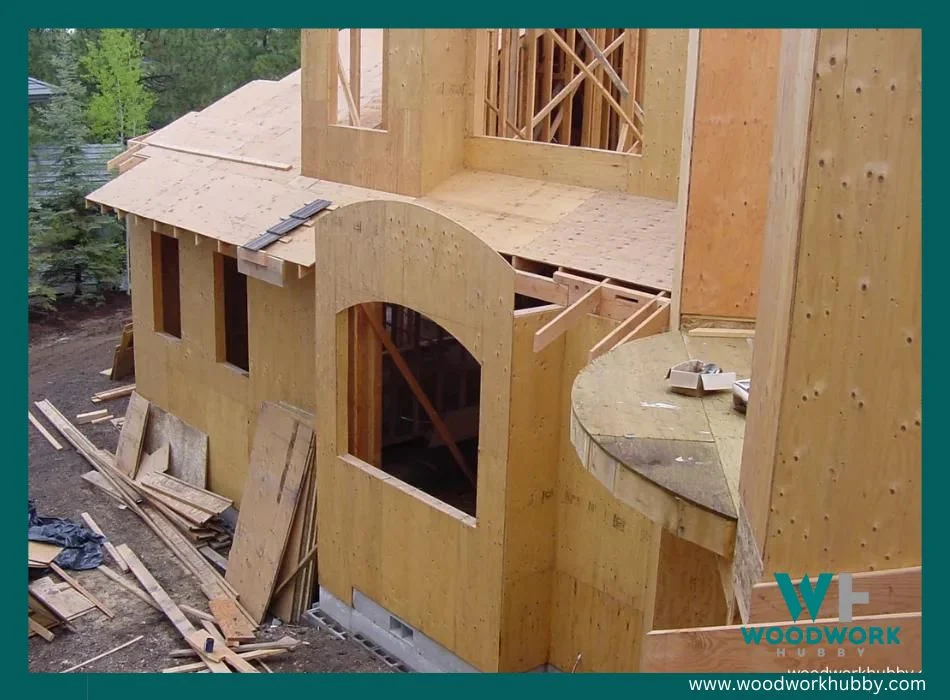
Any material between surface A and surface B sheaths A from B and vice-versa. “Sheathing” also refers to the material that is used for the act of sheathing. In construction, plywood, OSB, gypsum, cement board, and glass mat are all used for structural sheathing.
If Surface A and Surface B are tough, the sheath between them has to be durable. When Surface A is hit, the impact shouldn’t transfer to surface B. Structural sheathing provides this cushion from impact.
If surface A and surface B don’t get hit often, then it might appear that sheathing isn’t important. Well, structural sheathing might not be important, but some sort of sheathing is still required to avoid brittleness.
The sheathing that regulates temperature is often thick, and it prevents the temperature from passing between the surfaces. If thick plywood is used between the exterior and interior of a wall, the heat from the sun will not transfer to the room’s interior as rapidly. Similarly, in cold weather, the artificial heating inside the room will not escape rapidly via direct conduction.
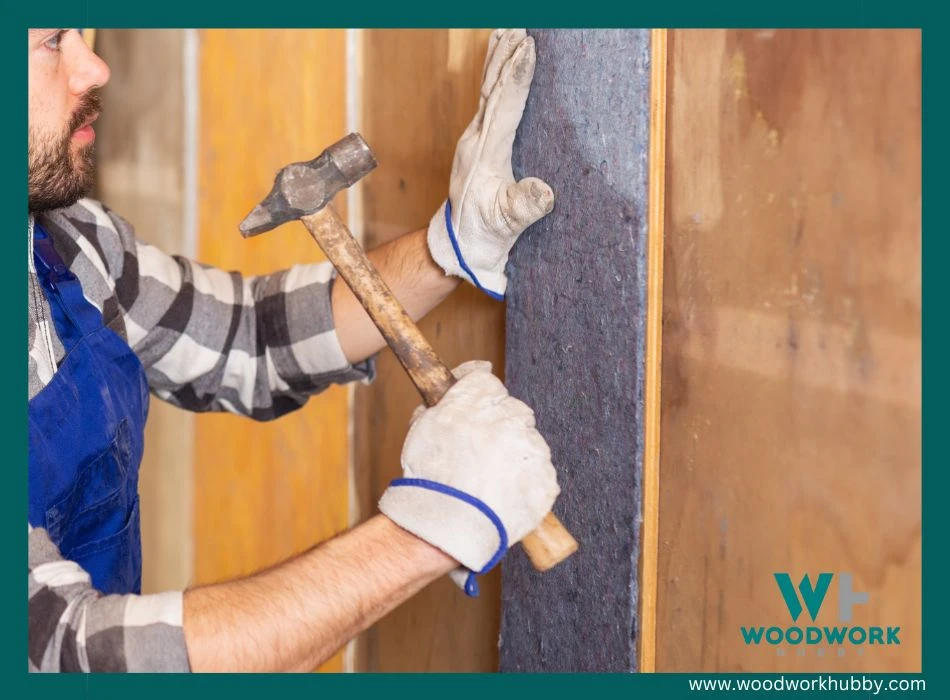
Between the two types of sheathing, structural sheathing is considered more important. That’s because sheathing for insulation can be done with insulation coating. That’s why, for the rest of this post, I will refer to “structural sheathing plywood” as “plywood sheathing.” This is mainly because structural sheathing has a temperature regulation function while a temperature controlling layer isn’t always integral to the structure.
Here is a video showing how to install wall sheathing:
Video showing how to sheath internal walls
What Is Sheathing Plywood Used For?
Sheathing plywood is a versatile construction material primarily used as a structural component in the building industry. It is typically made from multiple layers or plies of wood veneers bonded together with adhesive, resulting in a strong and durable panel.
Sheathing plywood serves a crucial role in construction projects as it provides stability and support to the building’s framework. It is commonly used as an exterior covering for residential and commercial structures, acting as a protective barrier against the elements.
Additionally, sheathing plywood helps distribute loads and forces across the framing members, enhancing the overall structural integrity of the building. Its flat and smooth surface also makes it suitable for attaching various finishes, such as siding, stucco, or insulation, to create a weatherproof and aesthetically pleasing exterior.
I have used sheathing plywood internally for the following applications:
- creating partitions
- subfloors
- roof decking
Its widespread use in construction owes to its affordability, ease of installation, and adaptability to various building designs and applications.
Is Sheathing The Same As Plywood?
Sheathing is not the same as plywood, nor is ‘plywood sheathing’ strictly the same as standard plywood. Sheathing is a material used to cushion the walls for better temperature regulation and impact resistance. Plywood sheathing is made of plywood, but other sheathing options exist as well.
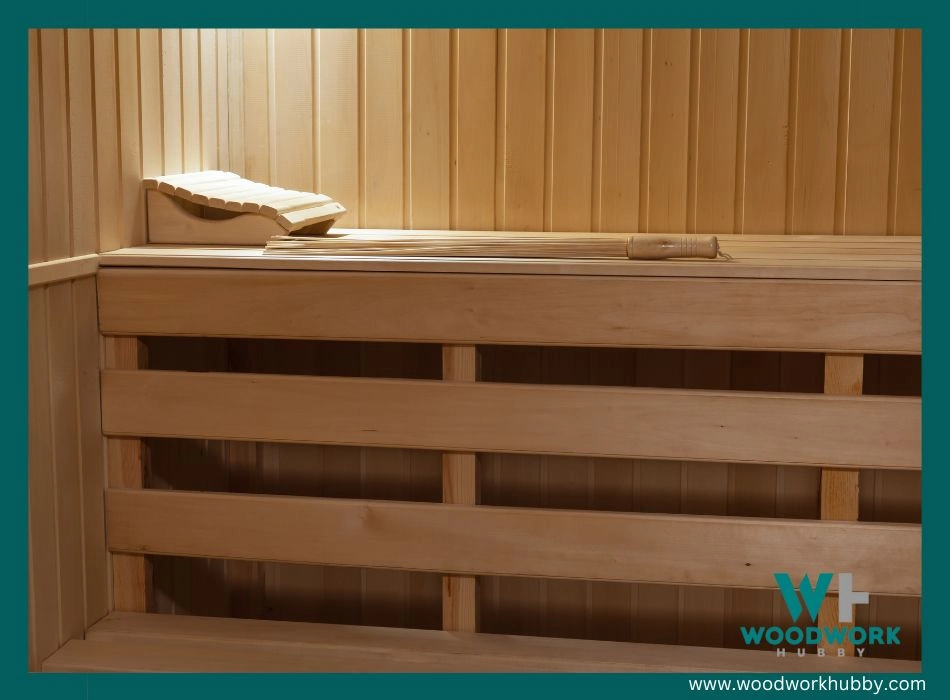
Knowing that plywood sheathing is not your only option can broaden your choices and help you make one you won’t regret. Plywood and OSB are the two main sheathing materials for walls.
Even though plywood isn’t the same as sheathing, it is often the material used for it. Sheathing plywood is thicker than the average plywood. It features more layers and is meant to help with insulation.
The table below covers where you can use plywood sheathing and where not to use it.
| Location/Aspect | Recommended Sheathing |
|---|---|
| Roof | OSB |
| Flooring | Plywood sheathing |
| Framing | Plywood sheathing |
| Beams | Plywood sheathing |
| Walls | OSB |
Is Sheathing Plywood Waterproof?
Sheathing plywood is not waterproof, but sheathing made from marine-grade plywood is practically waterproof. One can use waterproof varnish to keep the plywood from succumbing to water exposure, but since the sheathing is already covered, it doesn’t have to be waterproof.
This applies even in water-rich environments like the kitchen and bathroom walls. The waterproofing burden should be on the exposed area, not the insulation material sandwiched between exposed areas.
Can You Use Sheathing Plywood Outside?
Sheathing plywood can be used outside but needs to be sufficiently waterproofed wherever it is exposed. Structural plywood is untreated, unlike furniture plywood, which means that using it anywhere it can be exposed to humidity can lead to rapid degradation.
Rust-Oleum Urethane Water Based Finish can be used to waterproof plywood. This water-based finish is durable enough to be used on exterior wood surfaces. If it can make exposed wood waterproof, it can definitely make sheathing plywood (which is generally water-resistant) waterproof too.
It can be used to cover all plywood sheathing or only the sheathing that goes is used for kitchen and bathroom walls. Is this necessary? Not if the sheathing remains covered. But the finish is still a decent one to get for the material that will cover the sheathing plywood.
Because it is non-yellowing and makes wood glossy, any finish left over from waterproofing plywood can be used to freshen up your furniture.
That said, this finish is meant for exposed surfaces as it maintains its visual appeal. Using it on something that people don’t really see can be a bit of an overkill. But if you can pay for this finish within your budget, go for it. It is cheaper than the average waterproof plywood.
How Strong Is Sheathing Plywood?
Sheathing plywood is strong enough to handle 22 pounds of pressure per square foot. A few variations of plywood can handle up to 164 pounds. You can make your buying decision for sheathing material based on its thickness (and resultant strength) or its design compatibility.
3/8-inch plywood is sufficient for wall sheathing but doesn’t have enough strength to handle heavy impact. 1-inch plywood can withstand almost every practically possible type of impact in this context but makes your walls too thick. 3/8th of an inch is considered the standard for plywood sheathing because it strikes the sweet stop between insulation and flexibility.
Be sure to check out my article – Everything Plywood which is a great resource for plywood weights and strength.
If your sheathing handles force better than the surface, the surface will crack because of the rigidity of the plywood. You have to factor in the cost as well. As it is, plywood is more expensive than OSB of equivalent width.
Video showing sheathing options and strength of plywood
Going for a wider option and incurring waterproofing charges as well can make plywood sheathing one of the most expensive choices for your walls. In my experience, it doesn’t offer enough benefits to justify this cost.
What Types of Plywood Are Used for Sheathing?
Softwood plywood is used for sheathing because rigidity can be damaging to the overlay. Sources of said plywood include spruce, cedar, fir, redwood, and pine. As long as plywood is 3/8th of an inch or thicker and is derivative of softwood, it is fit for wall sheathing.
In contrast, hardwood plywood is better for sheathing beams and pressure-bearing areas because the plywood’s durability results in better impact insulation and support. This is echoed by the commonly available sheathing plywood options, which almost never feature hardwood sources.
But that can also be because hardwood plywood is generally less common.
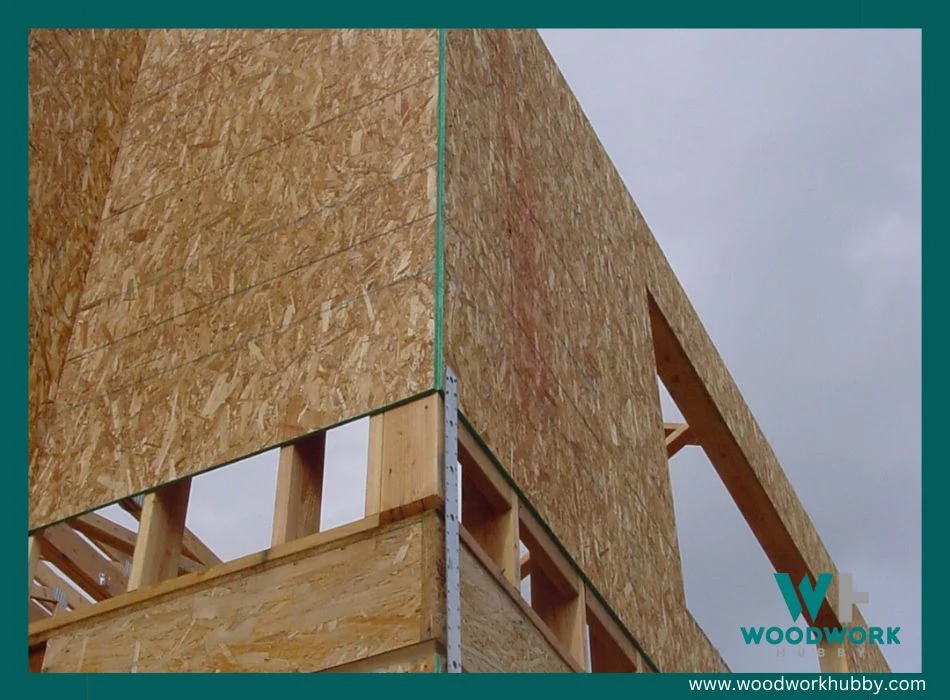
Still, it is worth checking what a specific plywood sheet is made from. You should prefer softwood sources like the ones mentioned above and waterproof adhesives.
Plywood Sheathing vs. Plywood
Plywood and Sheathing Plywood are somewhat connected but are far from the same. In fact, the biggest mistake people make when using plywood for insulation is to treat standard plywood as sheathing plywood.
In best cases, the plywood boards work as a sheath, albeit inefficiently. But in worst cases, the hard, thin plywood sheets provide no insulation, and the wall material crumbles on impact.
The first consequence (no noticeable insulation) is far more common. Since walls aren’t hit very often, their sheathing’s role isn’t to structurally insulate walls anyway. One can get away with using the wrong plywood and still having their walls stand crack-free.
But if the plywood used isn’t thick enough, it can easily let heat transfer through the walls without being an obstacle.
You can avoid this mistake by knowing what makes plywood a decent sheathing material. Here are a few things to remember:
- Sheathing plywood is thick but not too thick – If plywood is too thin, it cannot insulate the walls sufficiently. If it is too thick, it can be expensive and may lack flexibility.
- Flexibility is desirable in sheathing plywood – Sheathing plywood needs to be flexible in order to support the overlying material when subject to impact.
- Sheathing plywood is inexpensive – If plywood is suspiciously expensive, avoid using it for wall sheathing as it will need to be replaced. Expensive plywood is made from hardwood and even has a veneer overlay. It is the worst type to use as sheathing.
- Plywood sheathing is unfinished – Sheathing plywood isn’t waterproof, and if there is a chance of the sheathing being exposed to water at any point, you should apply waterproof varnish over it.
Sheathing Plywood Uses
Plywood sheathing is used for flooring and beams instead of walls because it has structural durability and can do a better job at insulating weight-bearing surfaces as compared to weather-protecting ones. This is in stark contrast to OSB sheathing, which is best used for heat insulations in walls.
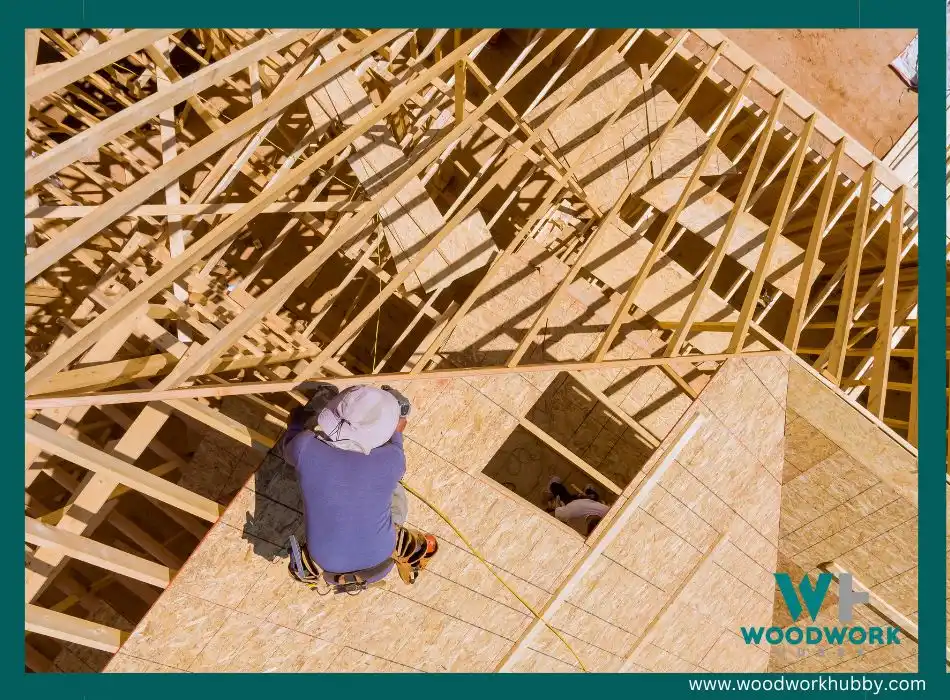
People often assume that OSB and plywood sheathing are interchangeable when that’s not the case. OSB is cheaper than plywood and is often preferred for wall sheathing simply because of the lowest cost for the area covered.
However, that doesn’t mean it can be used anywhere plywood underlayment is integral. OSB lacks the strength to handle floor sheathing and beam sheathing tasks. Moreover, OSB cannot be used effectively in bracing and framing panels. Plywood is far better in both those contexts.
The reason people think OSB and plywood are interchangeable is that both wood boards are among the top sheathing materials. But sheathing is a two-pronged task. It can be laid to improve the durability of the constructed structure or to make sure it is sufficiently insulated to avoid overheating or overcooking.
OSB and Plywood are very different. See my article about which is best for attic & sub floors that explains these fully.
OSB has thick fibers/flakes, which makes it relatively weaker. It takes only a few hits to break even a thick board. But because of said thickness, OSB is much better at handling, and preventing heat from passing through.
I have put together this handy table showing the different types of sheathing and what they are used for.
| Types of Sheathing Plywood | Common Uses Of Each Type |
|---|---|
| OSB (Orientated Strand Board) | Roof decking |
| Wall and ceiling sheathing | |
| Subflooring | |
| Exterior siding underlayment | |
| CDX Plywood | Roof sheathing |
| Exterior wall sheathing | |
| Subflooring | |
| APA Rated Plywood | Roof sheathing |
| Wall sheathing | |
| Floor underlayment | |
| T1-11 Plywood Siding | Exterior siding |
| Pressure-Treated Plywood | Exterior applications requiring moisture resistance |
| Foundation and deck construction | |
| Plywood Underlayment | Flooring underlayment |
| Tile and vinyl flooring subbase | |
| Fire-Rated Plywood | Fire-resistant wall and ceiling sheathing |
| ACX Plywood | Furniture construction |
| Cabinetry | |
| Marine Plywood | Boat building and repair |
| Water-resistant applications | |
| Exterior Grade Plywood | Outdoor furniture |
| Decorative exterior elements |
Plywood can be acquired in equivalent thickness, but it costs more. And as long as a surface doesn’t get hit repeatedly, paying the extra sum to get plywood sheathing makes no sense.
Still, you can get away with using thick plywood boards instead of OSB in every context where you would use OSB as sheathing. But the same does not apply in reverse. OSB cannot be used in structural sheathing tasks, as it can break and give way under the material laid over it.
When choosing your plywood sheathing, be sure to check my article on how much does plywood weigh.
Should You Use OSB or Plywood for Sheathing?
If cost is not a factor, then in most cases, you should use plywood for sheathing as it is superior in everything but thickness. And you can customize the thickness (though you pay more for it). Most housebuilders make a hybrid choice.
The more expensive plywood boards are reserved for the most weight-bearing areas of the structure. These include beams and even a high-traffic floor. In the latter, plywood sheathing works as underlayment.
OSB should be used wherever the sheathing’s main job is to regulate temperature. To the extent that sheathing has to minimize physical impact, OSB is a poor choice.
Plywood sheathing’s reputation is often subject to what people associate with plywood in general. Most people have experience with cabinet-grade plywood and often assume that plywood sheathing is the same.
As a result, they think that plywood sheathing isn’t durable enough. As long as plywood features the right glue/adhesive, it can be a very potent tool for structural insulation.
This video covers OSB vs Plywood with emphasis on cost:
Video about differences between OSB and Plywood costs
Where Do You Get Sheathing Plywood?
You can get sheathing plywood from construction material shops. Request “structural plywood” or “sheathing ply,” and the staff will guide you to the right plywood boards. Avoid finished plywood or boards that look laminated or covered in veneer. You need raw, untreated boards.
Final Thoughts – What Is Sheathing Plywood?
Plywood sheathing is thick and tough plywood that can be used to insulate walls, flooring, beams, and frames from physical impact as well as the elements and high temperatures. It is not waterproof and needs to be covered or coated to avoid water damage.
And if you are on a tight budget, you can use OSB for the walls and the roof and sheathing ply for flooring and beams.

